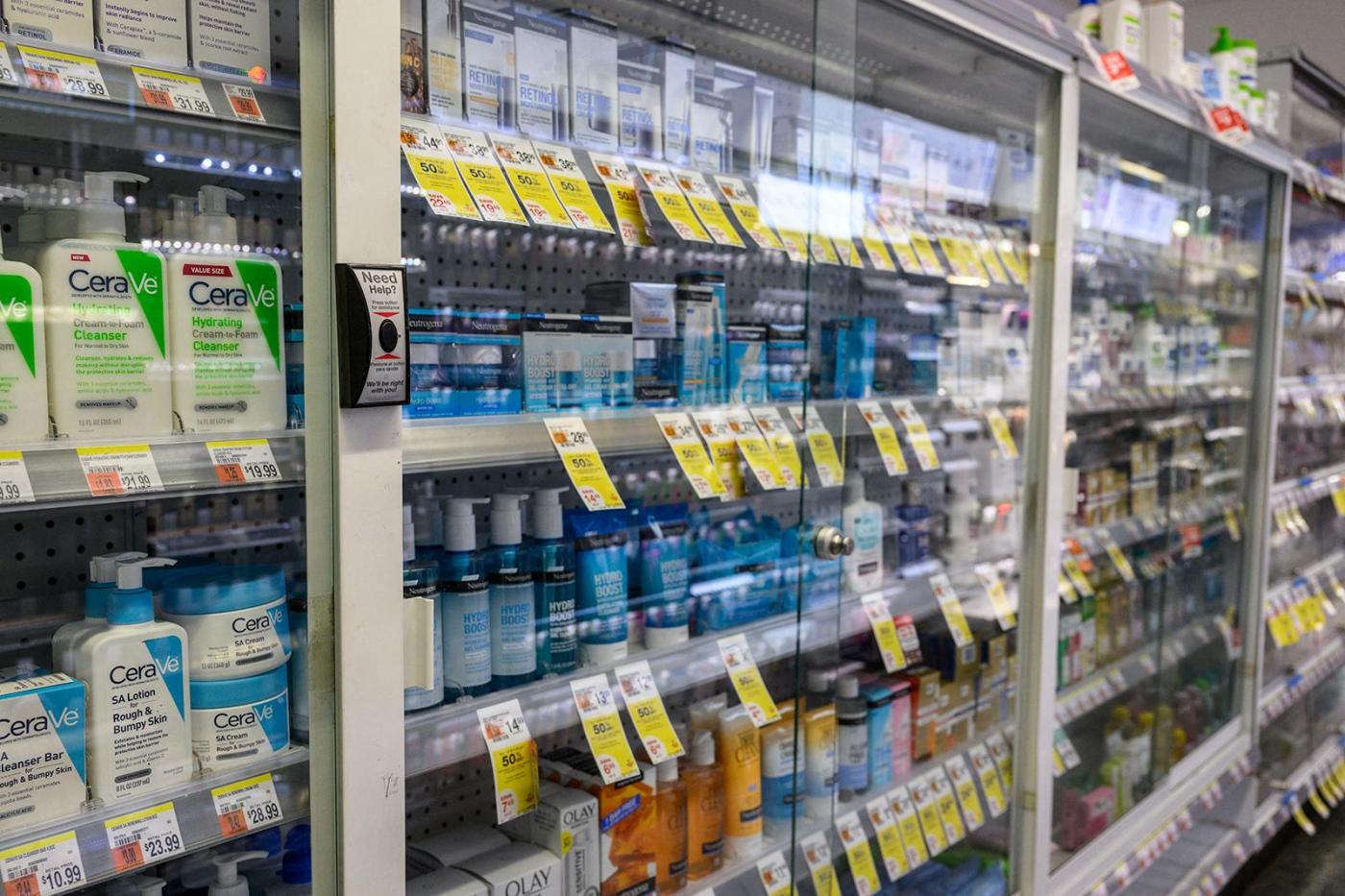
New shoplifting data explains why they’re locking up the toothpaste
Amanda Hernández | (TNS) Stateline.org
CHICAGO — Shoplifting rates in the three largest U.S. cities — New York, Los Angeles and Chicago — remain higher than they were before the pandemic, according to a report last month from the nonpartisan research group Council on Criminal Justice.
Related Articles
Nicotine pouches are selling fast — and falling into minors’ hands
‘Alarming’ new car prices push Bay Area buyers toward used vehicles, but they’re pricey, too
Norovirus is rampant. Blame oysters, cruise ships and holiday travel
Mega Millions jackpot nears $1 billion ahead of Christmas Eve drawing
The Container Store, buffeted by rough housing market and competition, seeks bankruptcy protection
The sharp rise in retail theft in recent years has made shoplifting a hot-button issue, especially for politicians looking to address public safety concerns in their communities.
Since 2020, when viral videos of smash-and-grab robberies flooded social media during the COVID-19 pandemic, many Americans have expressed fears that crime is out of control. Polls show that perceptions have improved recently, but a majority of Americans still say crime is worse than in previous years.
“There is this sense of brazenness that people have — they can just walk in and steal stuff. … That hurts the consumer, and it hurts the company,” said Alex Piquero, a criminology professor at the University of Miami and former director of the federal Bureau of Justice Statistics, in an interview.
“That’s just the world we live in,” he said. “We need to get people to realize that you have to obey the law.”
At least eight states — Arizona, California, Florida, Iowa, Kansas, Louisiana, New York and Vermont — passed a total of 14 bills in 2024 aimed at tackling retail theft, according to the National Conference of State Legislatures. The measures range from redefining retail crimes and adjusting penalties to allowing cross-county aggregation of theft charges and protecting retail workers.
Major retailers have responded to rising theft since 2020 by locking up merchandise, upgrading security cameras, hiring private security firms and even closing stores.
Still, the report indicates that shoplifting remains a stubborn problem.
In Chicago, the rate of reported shoplifting incidents remained below pre-pandemic levels throughout 2023 — but surged by 46% from January to October 2024 compared with the same period a year ago.
Shoplifting in Los Angeles was 87% higher in 2023 than in 2019. Police reports of shoplifting from January to October 2024 were lower than in 2023. Los Angeles adopted a new crime reporting system in March 2024, which has likely led to an undercount, according to the report.
In New York, shoplifting rose 48% from 2021 to 2022, then dipped slightly last year. Still, the shoplifting rate was 55% higher in 2023 than in 2019. This year, the shoplifting rate increased by 3% from January to September compared with the same period last year.
While shoplifting rates tend to rise in November and December, which coincides with in-person holiday shopping, data from the Council on Criminal Justice’s sample of 23 U.S. cities shows higher rates in the first half of 2024 compared with 2023.
Researchers found it surprising that rates went up despite retailers doing more to fight shoplifting. Experts say the spike might reflect improved reporting efforts rather than a spike in theft.
“As retailers have been paying more attention to shoplifting, we would not expect the numbers to increase,” said Ernesto Lopez, the report’s author and a senior research specialist with the council. “It makes it a challenge to understand the trends of shoplifting.”
Impact on retailers, communities
In downtown Chicago on a recent early afternoon, potential shoppers shuffled through the streets and nearby malls, browsing for gifts ahead of the holidays.
Edward Johnson, a guard at The Shops at North Bridge, said that malls have become quieter in the dozen or so years he has worked in mall security, with the rise of online retailers. As for shoplifters, Johnson said there isn’t a single type of person to look out for — they can come from any background.
“I think good-hearted people see something they can’t afford and figure nothing is lost if they take something from the store,” Johnson said as he patrolled the mall, keeping an eye out for lost or suspicious items.
Between 2018 and 2023, most shoplifting in Chicago was reported in the downtown area, as well as in the Old Town, River North and Lincoln Park neighborhoods, according to a separate analysis by the Council on Criminal Justice.
Newly sworn-in Cook County State’s Attorney Eileen O’Neill Burke this month lowered the threshold for charging retail theft as a felony in the county, which includes Chicago, from $1,000 to $300, aligning it with state law.
“It sends a signal that she’s taking it seriously,” Rob Karr, the president and CEO of the Illinois Retail Merchants Association, told Stateline.
Nationally, retailers are worried about organized theft. The National Retail Federation’s latest report attributed 36% of the $112.1 billion in lost merchandise in 2022 to “external theft,” which includes organized retail crime.
Organized retail crime typically involves coordinated efforts by groups to steal items with the intent to resell them for a profit. Commonly targeted goods include high-demand items such as baby formula, laundry detergent and electronics.
The same report found that retailers’ fear of violence associated with theft also is on the rise, with more retailers taking a “hands-off approach.” More than 41% of respondents to the organization’s 2023 survey, up from 38% in 2022, reported that no employee is authorized to try and stop a shoplifter.
(The federation’s reporting has come under criticism. It retracted a claim last year that attributed nearly half of lost merchandise in 2021 to organized retail crime; such theft accounted for only about 5%. The group announced this fall it will no longer publish its reports on lost merchandise.)
Increased penalties
Policy experts say shoplifting and organized retail theft can significantly harm critical industries, drive up costs for consumers and reduce sales tax revenue for states. Those worries have driven recent state-level action to boost penalties for shoplifting.
California Democratic Gov. Gavin Newsom signed a package of 10 bills into law in August aimed at addressing retail theft. These measures make repeated theft convictions a felony, allow aggregation of crimes across multiple counties to be charged as a single felony, and permit police to arrest suspects for retail theft even if the crime wasn’t witnessed directly by an officer. In September, Newsom signed an additional bill that imposes steeper felony penalties for large-scale theft offenses.
California voters also overwhelmingly approved a ballot measure in November that increases penalties for specific drug-related and theft crimes. Under the new law, people who are convicted of theft at least twice may face felony charges on their third offense, regardless of the stolen item’s value.
“With these changes in the law, really it comes down to making sure that law enforcement is showing up to our stores in a timely manner, and that the prosecutors and the [district attorneys] are prosecuting,” Rachel Michelin, the president and CEO of the California Retailers Association, told Stateline. “That’s the only way we’re going to deter retail theft in our communities.”
In New Jersey, a bipartisan bill making its way through the legislature would increase penalties for leading a shoplifting ring and allow extended sentences for repeat offenders.
“This bill is going after a formally organized band of criminals that deliver such destruction to a critical business in our community. We have to act. We have to create a deterrence,” Democratic Assemblymember Joseph Danielsen, one of the bill’s prime sponsors, said in an interview with Stateline.
The legislation would allow extended sentences for people convicted of shoplifting three times within 10 years or within 10 years of their release from prison, and would increase penalties to 10 to 20 years in prison for leading a retail crime ring.
The bill also would allow law enforcement to aggregate the value of stolen goods over the course of a year to charge serial shoplifters with more serious offenses. Additionally, the bill would increase penalties for assaults committed against retail workers, and would require retailers to train employees on detecting gift card scams.
Maryland legislators considered a similar bill during this year’s legislative session that would have defined organized retail theft and made it a felony.
The bill didn’t make it out of committee, but Cailey Locklair, president of the Maryland Retailers Alliance, said the group plans to propose a bill during next year’s legislative session that would target gift card fraud.
Retail theft data
Better, more thorough reporting from retailers is essential to truly understanding shoplifting trends and its full impact, in part because some retail-related crimes, such as gift card fraud, are frequently underreported, according to Lopez, of the Council on Criminal Justice.
Measuring crime across jurisdictions is notoriously difficult, and the council does not track organized retail theft specifically because law enforcement typically doesn’t identify it as such at the time of arrest — if an arrest even occurs — requiring further investigation, Lopez said.
The council’s latest report found conflicting trends in the FBI’s national crime reporting systems.
The FBI’s older system, the Summary Reporting System, known as SRS, suggests that reported shoplifting hadn’t gone up through 2023, remaining on par with 2019 levels. In contrast, the FBI’s National Incident-Based Reporting System, or NIBRS, shows a 93% increase in shoplifting over the same period.
The discrepancy may stem from the type of law enforcement agencies that have adopted the latter system, Lopez said. Some of those communities may have higher levels of shoplifting or other types of property crime, which could be what is driving the spike, Lopez said.
Despite the discrepancies and varying levels of shoplifting across the country, Lopez said, it’s important for retailers to report these incidents, as doing so could help allocate law enforcement resources more effectively.
“All law enforcement agencies have limited resources, and having the most accurate information allows for not just better policy, but also better implementation — better use of strategic resources,” Lopez said.
Stateline staff writer Robbie Sequeira contributed to this report.
©2024 States Newsroom. Visit at stateline.org. Distributed by Tribune Content Agency, LLC.


